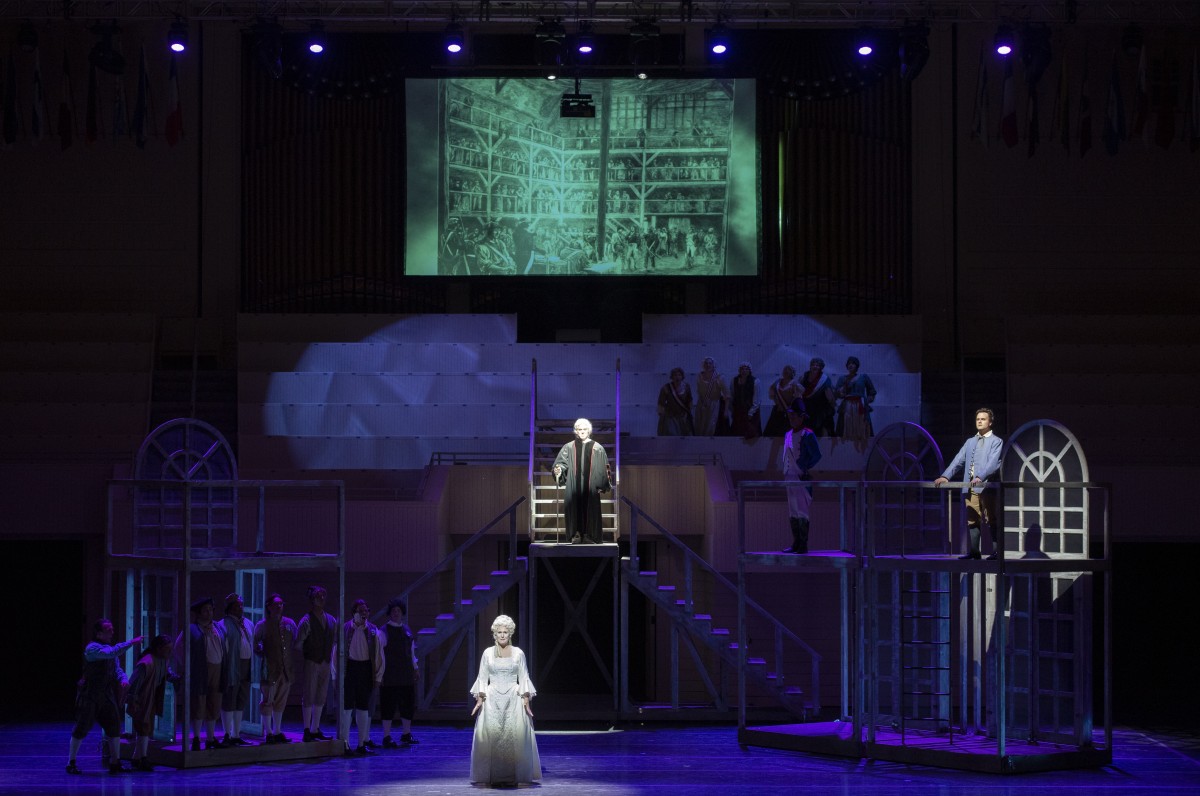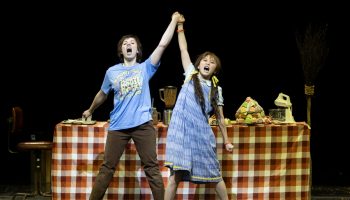Guest Critic: Tom Di Nardo
Suppose a playwright could rewrite the past, avert the French Revolution and keep his love, Queen Marie Antoinette, from the guillotine? To pull off this premise, he’d simply invent characters to accomplish it in an opera — until one of his own fictional creations refused to cooperate.
Even more layers of dramatic imagination were fashioned by librettist William M. Hoffman, then set to music by John Corigliano, in The Ghosts of Versailles, in its Chautauqua Opera Company performance at the Amphitheater last Saturday evening.
By the time the Metropolitan Opera was looking for a composer to celebrate its 100th anniversary in 1991, Corigliano was widely celebrated for his powerful First Symphony and other symphonic works. His flexibility in writing the Oscar-nominated film score to “Altered States” did not go unnoticed (his Oscar-winning “The Red Violin” would come a few years later). And Hoffman’s conception of Beaumarchais’ final drama, The Guilty Mother, expanded the original and transformed this into a play within a play — and then some.
The gestation of this opera helps to place Chautauqua Opera’s formidable challenge into perspective, considering that the Met utilized its enormous production resources and provided famed stars in major and cameo roles. Yet the settings for Chautauqua Opera’s production, designed by Alan Muraoka, worked splendidly, using three constantly rolling structures with windows and doors, and two stairways plus occasional relevant projections.
This show requires a large cast of around 40, and Peter Kazaras’ direction clarified the spectral, theatrical and real characters and, usually, their individual motivations. To make this venture even more impressive, the company’s resources were utilized on the two days before with reprises of the first two classics of the Beaumarchais trilogy, The Barber of Seville and The Marriage of Figaro.
Titles were also projected, essential for any English-language opera.
Beaumarchais’ final play continues the adventures of the well-known characters years later. Countess Rosina has had a son, Léon, with the frisky Cherubino, and Count Almaviva fathered a daughter, Florestine, from another dalliance. Rosina and the Count refuse to allow the two youngsters to marry. The evil Bégearss hopes to steal Léon’s inheritance and marry Florestine himself, but Figaro and Susanna connive once again to ensure a happy ending.
Hoffman took this plot many steps further, setting the story in the Petit Trianon in Versailles, where bored, white-wigged and elegantly dressed ghosts are waiting for a Beaumarchais opera, A Figaro for Antonia, to begin. Beaumarchais is in love with Marie Antoinette, hoping for his play to rewrite history, while the money from a valuable necklace may allow their escape. To Beaumarchais’ astonishment, his own creation Figaro takes the necklace but has no interest in saving Marie, hoping to rescue the Almaviva family instead. Beaumarchais makes Figaro sympathetic to Marie after showing him her mock trial but, in entering his own opera, loses his power to manipulate his characters. The evil Bégearss tries to arrest Almaviva and marry Florestine, but Figaro and Susanna again prevail. The Count, Countess, Figaro, Susanna, Léon and Florestine escape in a balloon to Philadelphia (where the real Marriage of Figaro librettist Lorenzo da Ponte would soon arrive in 1805), and Marie accepts Beaumarchais’ love for her — and her tragic fate.
The singing in this opera was uniformly excellent, despite the difficulty of many of the vocal parts. Corigliano didn’t write any arias you’d go home humming, but the passion inherent in each one kept listeners involved in what the singing was about, and why. Soprano Caitlin Lynch, as Marie, sang many passages high above the staff, and handled them formidably with a minimum of screeching, no easy feat when her painful memories ended in near-hysteria. Baritone Daniel Belcher was an affecting Beaumarchais; tenor Patrick Dean Shelton was a nasty Bégearss; Aleks Romano did a cameo, some in Turkish, as Samira; and baritone Marco Nisticò portrayed Louis XVI by zinging a bunch of funny one-liners.
These guest artists and Young Artist Shelton are mentioned first, only to emphasize that the many other roles were handled with impressive vocal and acting skill by upcoming singers from the company’s deep Young Artists roster. They included a funny and rambunctious Figaro (baritone Scott Purcell); very believable Susanna (mezzo-soprano Quinn Middleman); Almaviva (tenor Blake Friedman) and Rosina (soprano Lauren Yokabaskas), as well as the young lovers Léon (tenor James Stevens) and Florestine (soprano Natalie Trumm); all head into the “I heard them when” category. The Lady in the Hat, a cacophonic trio of women in white dresses, and lots of excellent costumes added to the entertainment value, as well as the necessity for a sea of white hairpieces.
Purcell, as Figaro, catalogued his many past talents in an homage to his famous aria in Barber, this time almost like a Gilbert-and-Sullivan patter song. He was constantly being chased around, but never caught and, as always, makes himself the soul of the show.
Some hilarious moments: The jealous King and Beaumarchais in a duel, with the playwright impaled until they realize they are both dead; Samira’s wiggly dance and goofy aria at the Turkish embassy, with Figaro flouncing around dressed as a dancer to swipe the necklace; and the very curious “Long Live The Worm” pronouncement by the reprehensible Bégearss.
And some glorious moments, too: Marie’s initial aria, in which she just wants to forget her past, a duet between Rosina and Susanna (recalling their magical one in Figaro), and a flashback of mirrored duets between imminent lovers Rosina and Cherubino, while Marie and Beaumarchais become close as well.
Conductor Steven Osgood, the company’s general and artistic director, always seems to come up with a savvy season combination of classics and cutting-edge choices. For the company’s 90th anniversary, to embark on this famous trilogy seemed like a stretch — though one reached with a level of polish that would impress anywhere. His conducting of this difficult and very sophisticated score was exemplary, with some outstanding woodwind and horn work.
Hoffman created plenty of strange moments and odd detours, and the first act even ends with a title saying “THIS IS NOT AN OPERA!” But it is still captivating, mostly because of the fascinating concept Hoffman has created, and the skill and care brought to this performance.
Despite the usual acceptance by Chautauquans of unfamiliar repertory, Ghosts deserved better than the sparse attendance in the side risers. Nevertheless, there was no disappointment in the face of attending composer John Corigliano, who came up onto the stage to share the ovation. He’s written a work that requires plenty of talent in a variety of disciplines, and the present performance provided them all in another proud addition to the company’s 90-year catalog.
Tom Di Nardo is a Philadelphia writer on the arts. His recent books include Listening to Musicians: 40 Years of the Philadelphia Orchestra and Performers Tell Their Stories: 40 Years Inside the Arts. He has also written Wonderful World of Percussion: My Life Behind Bars, a biography of legendary Hollywood percussionist Emil Richards.







